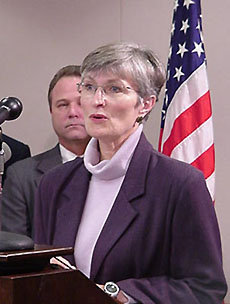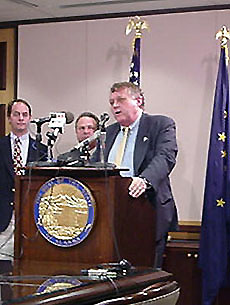 October 03, 2002
"This report shows that Alaska can act even if Congress is in gridlock over ways to make prescription drugs more affordable," Lt. Governor Fran Ulmer said. "The high cost of some medicines not only affects all of our pocketbooks, it also costs the state government money - some $62 million in additional Medicaid expenses last year." Wednesday, Ulmer received a report from the special task force, which was appointed by Gov. Tony Knowles to examine why Alaska ranks high in the price and use of prescription medicines and what can be done to make the medicines more affordable for elderly and disabled Alaskans. The group, including state health and insurance officials, a licensed pharmacist, a senior advocate and a representative of the insurance industry, held several public hearings and drafted a 27-page report for review by the governor. "I thank the task force members for committing their time, expertise and energy to look at this problem and recommend steps we can take to better serve the health care needs of Alaskans," Knowles said. "These recommendations will get a thorough review for possible inclusion in next year's budget and legislative packages. This report also looks to be an excellent blueprint for discussions by the next administration and Legislature." The task force estimates that total prescription drug spending for Alaskans 65 and older will more than double in the next five years - to $187 million in 2007. Task force members said Alaska should consider a direct benefit program that qualifies the state for the best price exemption under Medicaid for prescription drugs. Such programs use state funds to subsidize prescriptions, usually for low-income seniors who do not qualify for Medicaid and have no private prescription coverage. They often require some co-payment by recipients. The task force said a direct benefit program could be combined with drug regimen reviews and education programs that could reduce the use of prescription medicines. "We have only to look to the experience of the Alaska Pioneer Home to see this," the task force wrote in its report. "By a simple review of all medications and discussions with the resident and his/her physician, drug usage was cut by 50 percent." Other recommendations in the report, further explained below, include:
"Many private foundations are willing to collaborate with state government to develop models that reduce prescription drug usage and costs," said task force chair John Patrick
The group also recommends expanded use of the 340B program, a program operated under the U.S. Department of Health and Human Services to provide covered outpatient drugs to participating entities at discounted prices. Under this program, discounts averaging 25-40 percent would be offered on most drugs and could be made available to older and younger disabled Alaskans. The task force also recommends incorporating a variety of cost control tools into the direct benefit program, including preferred drug lists, co-pays, deductibles and maximum benefit limits. The eligible population for the direct benefit program would be those over 65 and eligible for Medicare and those under 65 who receive Medicare benefits due to disability. Similar cost control recommendations were made for the Medicaid program. Members of the task force, in addition to Luby, were: Robert Albertson, licensed pharmacist, Anchorage Pioneers' Home; Steven Ashman, Division Director, Division of Senior Services, Department of Administration; Marie Darlin, senior advocate; Jeff Davis, Vice President and General Manager, Premera Blue Cross/Blue Shield of Alaska; Bob Lohr, Director, Division of Insurance, Department of Community and Economic Development; and Jonathan Sherwood, Division of Medical Assistance, Department of Health and Social Services.
Available Remarks:
Source of News Release & Digital Photos:
|
|||

